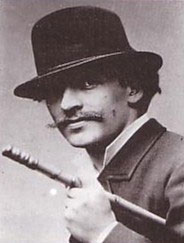Fantasmagorie (film)
| Fantasmagorie | |
|---|---|
 A still from the film | |
| Directed by | Émile Cohl |
| Produced by | Émile Cohl |
| Distributed by | Société des Etablissements L. Gaumont |
Release date | 17 August 1908 |
Running time | Approx. 1 minute, 20 seconds |
| Country | France |
| Language | Silent film |
Fantasmagorie is an 1908 French animated film by Émile Cohl. It is one of the earliest examples of traditional (hand-drawn) animation, and considered by film historians to be the first animated cartoon.[1]
Description

The film largely consists of a stick figure moving about and encountering all manner of morphing objects, such as a wine bottle that transforms into a flower. There were also sections of live action where the animator’s hands would enter the scene. The main character is drawn by the artist's hand on camera, and the main characters are a clown and a gentleman.
The film, in all of its wild transformations, is a direct tribute to the by-then forgotten Incoherent movement. The title is a reference to the "fantasmograph", a mid-Nineteenth Century variant of the magic lantern that projected ghostly images that floated across the walls.
History
Cohl worked on "Fantasmagorie" from February to either May or June 1908. Despite the short running time, the piece was packed with material devised in a "stream of consciousness" style. The film was released on August 17, 1908.
Production
The film was created by drawing each frame on paper and then shooting each frame onto negative film, which gave the picture a blackboard look. It was made up of 700 drawings, each of which was exposed twice (animated "on twos"), leading to a running time of almost two minutes. It borrowed from J. Stuart Blackton, the "chalk-line effect"; filming black lines on white paper, then reversing the negative to make it look like white chalk on a black chalkboard. Blackton and Cohl also borrowed some technics from Georges Méliès, such as the stop trick.
See also
References
- "Fantasmagorie (1908)". The Internet Movie Database. Retrieved May 2, 2010.
- ^ Beckerman, Howard (2003-09-01). Animation: the whole story. Skyhorse Publishing Inc. p. 17. ISBN 978-1-58115-301-9. Retrieved 16 August 2011.
External links
